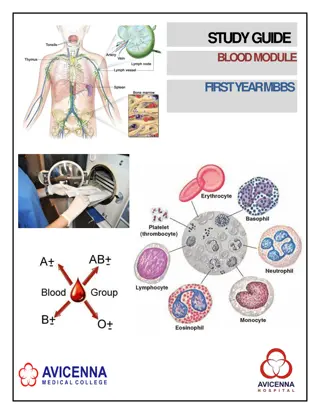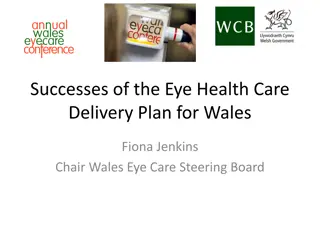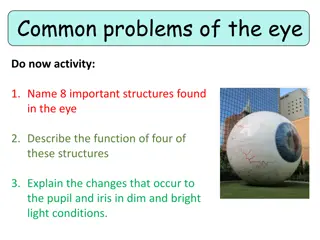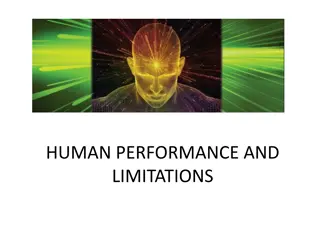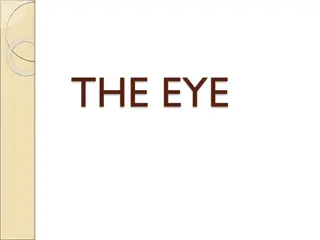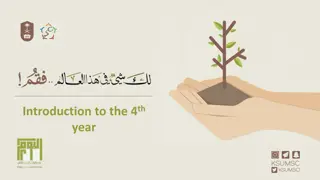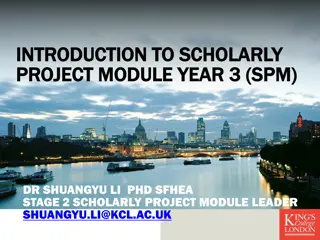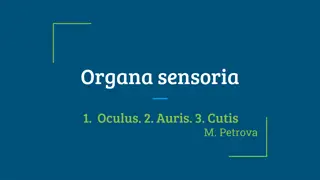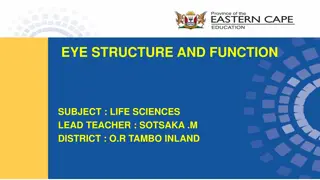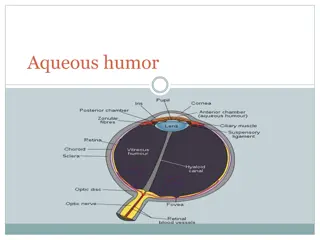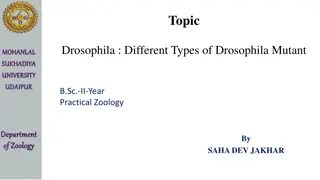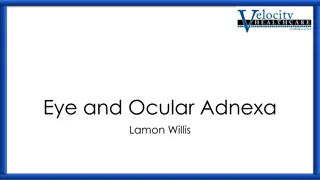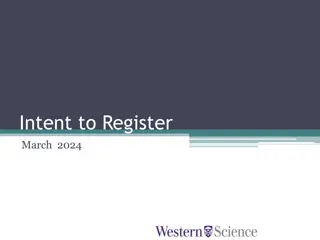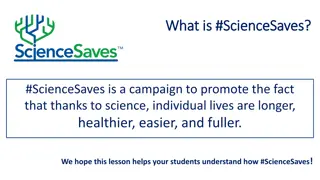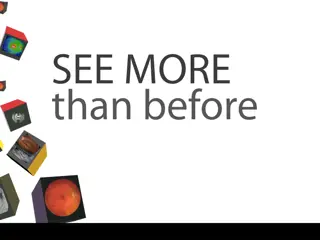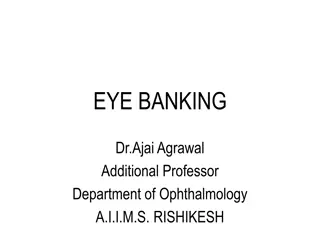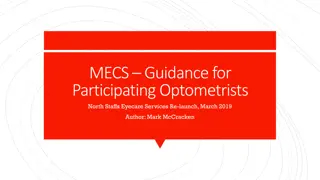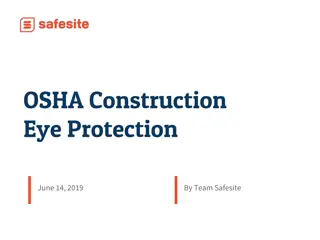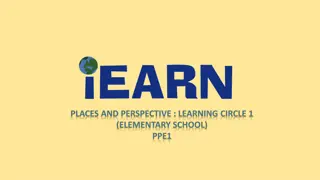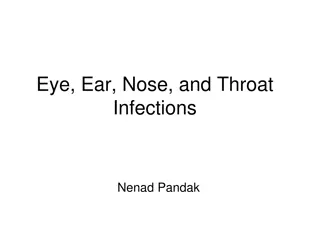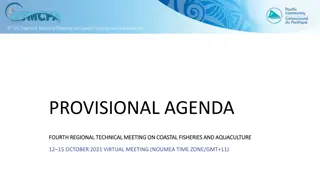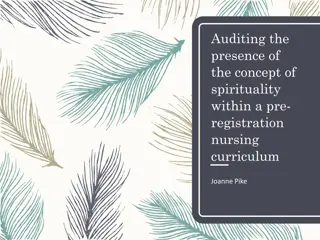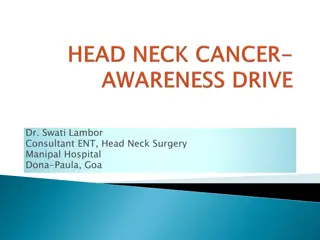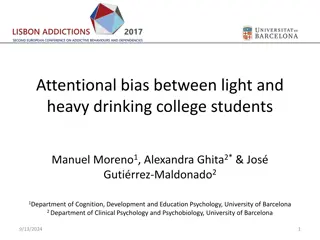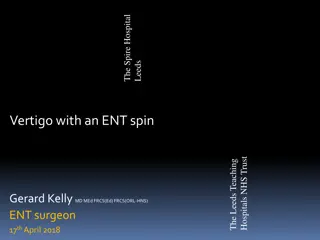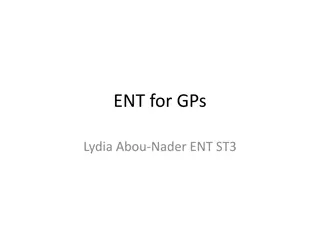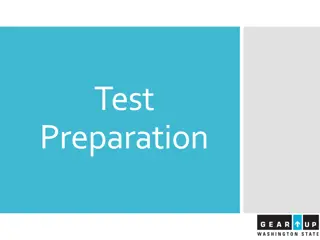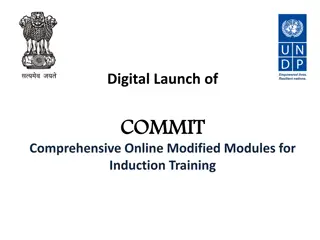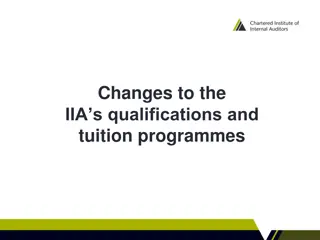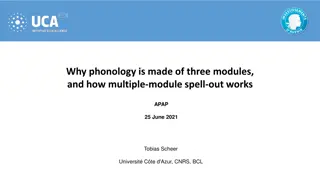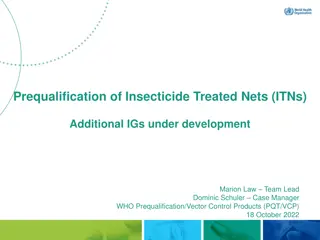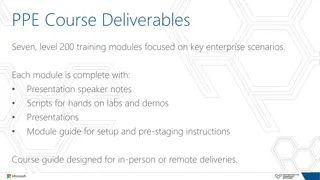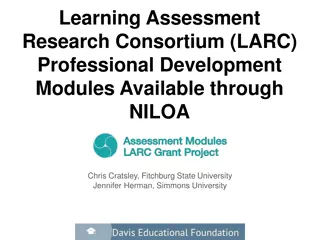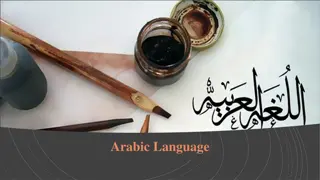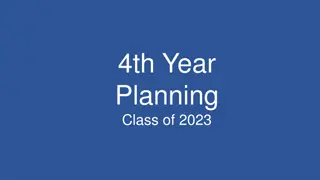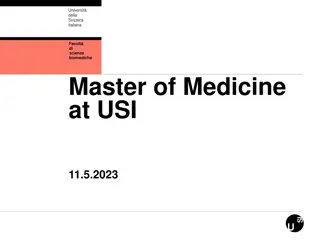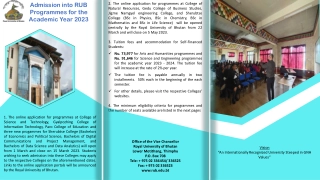Integrating ENT and Eye Modules in 4th Year MBBS Curriculum at Avicenna Medical College
Avicenna Medical College's 4th-year MBBS program integrates ENT and Eye modules in semester VII, following JSMU guidelines. Students experience a comprehensive curriculum combining basic sciences with clinical medicine, focusing on ENT diseases. The curriculum includes interactive lectures, tutorials, small group sessions, e-learning, and clinical postings to enhance learning and understanding. Community medicine and bioethics run parallel throughout the semester.
Download Presentation

Please find below an Image/Link to download the presentation.
The content on the website is provided AS IS for your information and personal use only. It may not be sold, licensed, or shared on other websites without obtaining consent from the author. Download presentation by click this link. If you encounter any issues during the download, it is possible that the publisher has removed the file from their server.
E N D
Presentation Transcript
STUDYGUIDE EAR, NOSE &THROAT MODULE FOURTH YEARMBBS
AVICENNA MEDICAL COLLEGE 4TH YEAR MBBS, SEAR, NOSE & THROATMODULE STUDYGUIDE EAR, NOSE & THROAT MODULE SEMESTER VII, FOURTH YEARMBBS Page No CONTENTS S.No 1 List of Integrated Modular CommitteeMembers 03 2 Introduction to IntegratedCurriculum 04 3 Learning Methodologies 06 4 Module: Ear, Nose & Throat 07 5 Importance 07 6 Objectives andStrategies Learning Resources AssessmentMethods 08 14 15 6.1 6.2 Semester Examination Rules and Regulations of UHS 7 17 8 Modular Examination Rules and Regulations(AVMC) 19 9 Schedule 20 10 Appendices A & B 21 Page | 2
AVICENNA MEDICAL COLLEGE 4TH YEAR MBBS, EAR, NOSE & THROATMODULE MODULE INTEGRA TEDCOMMITTEE Prof.Dr.Ayub Khan MODULECOORDINATOR: Dr.Rizwan Akbar Dr. Zulifqar Saleem. CO-COORDINATORS: DEPARTMENTS & RESOURCEPERSONS CLINICAL AND ANCILLARYDEPARTMENTS BASIC HEALTHSCIENCES ANATOMY Professor Rehana Shahid Professor Sonia Bashir ENT Professor.Ayub Khan Dr.Rizwan Akbar PHARMACOLOGY RESEARCH AND SKILLS DEVELOPMENTCENTER Prof. Rana Akhtar Professor Rana tariq mahmood PHYSIOLOGY Professor Binyamin Ahmed PLASTICSURGERY Dr. Zulifqar Saleem. PATHOLOGY Professor Robenna Hafeez LNH&MCMANAGEMENT Professorr.Dr. Gulfreen Waheed, Dean & Principal, Director AVMC Dr.Brg. Gul-e-ranaController AVMC Dr. Sadia Awan Dr. Muhammad Muzzammil Sadiq Dr. Usama Bin Ishtiaq STUDY GUIDE COMPILEDBY: Department of Health CareEducation Page | 3
AVICENNA MEDICAL COLLEGE 4TH YEAR MBBS, EAR, NOSE & THROATMODULE CURRICULUMFRAMEWORK Students will experience integrated curriculum in 4th year, semester VII at LNMC in accordance with the JSMU guidelines and most recent developments that have an impact on individual health. In semester VII, two groups of fifty students will be formed. Group I (A & B) of 50 students will experience ENT Module, and 50studentsof Group II(C& D)will experienceEyemodule.InsemesterVIII,thesegroupswill switch in order to get the whole batch of 4th year MBBS students trained for bothEye and ENT modules. INTEGRATED CURRICULUM is comprised of system-based modules such as ENT, Eye, Reproductive module II and Orthopedics. This integrates basic science knowledge of anatomy, physiology, pharmacology and pathology to clinical problems and presentations of ENT diseases. Integrated curriculum means that subjects are presented as a meaningful whole for better understanding of basic sciences in relation to clinical experience andapplication. COMMUNITYMEDICINE* BIO-ETHICS* ANATOMY PHYSIOLOGY ENT MODULE PLASTICSURGERY PA THOLOGY PHARMACOLOGY *CommunityMedicine& Bio-ethicswill run parallelthroughout the semester Page | 4
AVICENNA MEDICAL COLLEGE 4TH YEAR MBBS, S EAR, NOSE & THROATMODULE LEARNINGMETHODOLGIES The module focuses on integrating basic health sciences to clinical medicine. Teaching and learning methodologies will be a combination of interactive lectures, tutorials, small group sessions, and task oriented learning,e-learning, skills teachingsessionsandclinicalpostings. Teaching/LearningTechnique Icons Interactive Lectures Clinicalrotations Small Group Sessions/ Task oriented learning Case-BasedDiscussions Self-DirectedStudy E-Learning (edmodo, websites,podcasts) Page | 5
AVICENNA MEDICAL COLLEGE Task OrientedLearning 4TH YEAR MBBS, EAR, NOSE & THROATMODULE In this module, objectives will be achieved by using multiple instructional strategies other than lectures only. Task oriented learning is being introduced to enhance students learning and to get insight of the content necessary to move forward in to practical application of course materials. Students will be engaged in self directed learning as well as peers collaboration and faculty led instructions Process ofTOL Learningin this strategywill comprises of two stages Stage 1: Pre-class learning in groups Stage2: In-classgroupfocusedactivelearning Stage 1 (Pre-class) Stage 2 (In-class) Group presentation and assessment by facilitator followed by Q/Asession Individual/groupstudy and group presentationpreparation TOLprocessstage 1: Students will be divided in 6 groups (8-9 members in each group). Each week, students group will be given task based on few objectives. These objectives will be posted on edmodo(ForgroupingsseeAppendixB). Link for edmodo:https://support.edmodo.com/hc/en-us/articles/205009754-Student-Sign-Up Class name for Group A and B:4thyr jsmu VIIA Class code:w7yjvu Students will have defined time slots for achieving the objectives. They will be required to study the recommended authentic website (patient education websitesare strictly NOTADVISED!!!)and work in groupsto developpresentationsduringallotted studyhours. TOL process stage 2: The groups will then be required to present their PPT/Prezi in class to show their understanding of subjectmatter. Time for group presentation: Each presentation should not exceed 10 minutes followed by five minutesdiscussion Assessment The group presentations and collaborative work will be graded on defined criteria (See Appendix A). Each student is to demonstrate active participation and effective contribution during the group activities. It ismandatoryfor the studentsto participatein thisactivity astheir scoreswill contribute to internalevaluation. Page | 6
AVICENNA MEDICAL COLLEGE SEMESTER VII MODULE 1: Ear, Nose & Throat IMPORTANCE 4TH YEAR MBBS, EAR, NOSE & THROATMODULE As a general trend, disease burden is increasing with passage of time and is also true for common ENTproblems. According to a local study, the highest incidence is noted for ear diseases; especially discharging ear, followed by nose (rhinosinusitis) and throat (sore throat) respectively with a general increasing trend over the past decade (Z. Awan, 2009). So this module is designed to specifically address the basic needs of medical students as graduating doctors, enabling them to diagnose and treat common everyday diseases of ear, nose and throat and contribute to better overall healthcare. AIMS OF THISMODULE The module aims to provide: Knowledge and understanding of the structures and functions of the ear, nose and throat with application to clinical practice, integrating basic science knowledge to solve and manage common related diseasesincommunity Knowledge and understanding of the origin and associated risk factors of common diseases of ear, noseandthroat andapplicationin realcontext Application of knowledge in management and prevention of common pathologies of ear, nose and throat Practice of basicskills usedto diagnoseandtreat diseasesin asimulatedclinicalsetting Knowledgeof drugsusedto treatear,noseandthroat diseasesandtheir application Page | 7
AVICENNA MEDICAL COLLEGE COURSE OBJECTIVES & TEACHING LEARNINGSTRA TEGIES: 4TH YEAR MBBS, EAR, NOSE & THROATMODULE At theendof the module,the student will beable to NOSE OBJECTIVES SUBJECTS/ TOPICS TEACHING & LEARNING STRATEG IES Anatomy Correlate the anatomy of nose and paranasal sinuses with their clinicalpresentations Correlate the process of olfaction withdiseases of nasalcavity Explain the pathology of the diseases ofnasal cavity Physiology Interactive lectures/Small groupsessions Pathology Describe pharmacological treatment ofcommon nasalpathologies Advise prescriptions forrhinosinusitis Diagnose fractures of the external nose basedon history, clinical examination andinvestigation Develop management plan for trauma toexternal nose Diagnose epistaxis, deviated nasalseptum, hematoma, septal abscess andperforation Discuss management plans for epistaxis, deviated nasal septum, hematoma, septal abscess and perforation Definepolyps Diagnose ethmoidal and antrochoanalpolyps Discuss management plans for ethmoidaland antrochoanalpolyps Diagnose foreign bodies in nose (i.e. rhinoliths)based on clinical examination &investigation Discuss management plans for rhinolith Discuss the etiology, pathophysiology,clinical presentations, examination findings, investigations, differential diagnosis for acute and chronicsinusitis Discuss complications of sinusitis Develop treatment plan forsinusitis Describe the etiology, pathophysiology, clinical presentations, investigations and treatment plans for allergic rhinitis and rhinitis due toforeign bodies Diagnose fungal sinusitis based on the basis ofclinical presentation andinvestigations Pharmacology ENT Externalnose Septum Interactiv e lectures Polyps Foreignbody Sinusitis Task oriented learning/Small groupsessions Rhinitis Sinusitis Taskoriented learning Page | 8
AVICENNA MEDICAL COLLEGE 4TH YEAR MBBS, SEAR, NOSE & THROATMODULE Discuss management plans for fungalsinusitis Order investigations, develop differential diagnosis and treatment plans for headaches withemphasis on ENTcauses Diagnose congenital lesions of external nose (choanal atresia) based on clinical examination and investigation Discuss management plans for externalnose deformities Describe the etiology, pathophysiology, clinical presentations, investigations and treatment plans for common types of atrophic rhinitis, hypertrophic rhinitis andVMR Diagnose CSF rhinorrhoea based on clinical examination andinvestigations Diagnose bleedingpolyps Discuss management plans for bleedingpolyps Diagnose foreign bodies in nose (i.e. maggots) based on examination & investigations Discuss management plans for maggots ENT causesof headache Interactive lectures Externalnose Interactiv e lectures Rhinosinusitis Task oriented learning/Small groupsessions Polyps Interactiv e lectures Foreignbody EAR OBJECTIVES SUBJEC TS/ TOPICS Anatomy TEACHING & LEARNING STRATEGIES Correlate the anatomy of ear withclinical presentations of eardiseases Correlate the process of hearing withclinical presentations of eardiseases Correlate the pathogenesis of ear diseaseswith clinical presentations of eardiseases Describe pharmacological treatment ofcommon pathologies of ear Advise prescriptionsfor: 1. Otomycosis 2. Acute otitismedia 3. Otitis externa Discuss the etiology, investigations, treatmentand complications for acute otitisexterna Develop management plan for impacted waxand foreign body Physiology Interactive lectures/Small groupsessions Pathology Pharmacology Interactive lectures ENT Externalear Page | 9
AVICENNA MEDICAL COLLEGE 4TH YEAR MBBS, EAR, NOSE & THROATMODULE Discuss the etiology, pathophysiology, clinical presentations, examination findings, investigations and treatment plansfor: 1. Acute otitismedia 2. Serous otitis media 3. Chronic otitismedia Diagnosis and develop management plans for complications of otitis media andmastoiditis Interactiv e lectures/ Middle ear Case- based discussions Definedeafness List causes of deafness Interpret investigation findings related todeafness Diagnose deafness and mutism in achild Discuss the clinical presentations and treatment optionsfor: 1. Vestibularneuritis 2. Benign paroxysmal positionalvertigo 3. Meniere sDisease 4. Migraine-associatedvertigo Discuss the differential diagnosis, investigations and treatment of: 1. Tinnitus 2. AcousticNeuroma Describe management plan for pinna traumaand traumatic rupture of tympanicmembrane Discuss the etiology, investigations, treatmentand complications for malignant otitisexterna Discuss the clinical presentations, examination findings, investigations and treatment plans for benigntumors of externalear Discuss the etiology, investigations, treatmentand complicationsfor: 1. Myringitisbullosa, 2. Perichondritisand 3. Fungalinfections Discuss the clinical presentations, examination findings, investigations and treatment plans for malignanttumors of externalear Discuss the etiology, pathophysiology, clinical presentations, examination findings, investigations and treatment plans for acute necrotising otitismedia Discuss the clinical presentations, examination findings, investigations and treatment plans for benignandmalignanttumors of middleear Interactive lectures/ Small groupsessions/ Case-based discussions Innerear Externalear Interactiv e lectures Externalear Interactive lectures/ Case- based discussions Middle ear Page | 10
AVICENNA MEDICAL COLLEGE 4TH YEAR MBBS, EAR, NOSE & THROATMODULE HEAD & NECK, OROPHARYNX, LARYNX,OESOPHAGUS OBJECTVES SUBJECTS/ TOPICS TEACHING & LEARNING STRATEG IES Physiology Correlate the process of salivation, phonationand speech with common diseases oforopharynx Pathology Correlate the pathogenersis of the diseasesinvolving oral cavity, neck and salivary glands withclinical presentations of associateddiseases Correlate the anatomy of the oral cavity, salivary glands, larynx, pharynx, neck and oesophagus (oral, pharyngeal and oesophageal parts) with clinical presentations of associateddiseases Describe pharmacological treatment ofcommon oropharyngealpathologies Advise prescriptionsfor: 1. Acutetonsillitis 2. Peritonsillarabscess 3. Pharyngitis Discuss the risk factors, etiology and pathophysiology of: 1. BasalCell 2. SquamousCellCarcinoma 3. Papilloma 4. Osteoma Diagnose cleft palate, hare lip based onclinical presentation andinvestigations Correlate the embryological defects and etiologyof cleft lip and palate with theirclinical presentation Describe treatment options for cleft lipand palate Discuss the differential diagnosis for neck massbased on symptoms, signs andinvestigations Diagnose salivary gland conditions (neoplastic, non- neoplastic and parotitis) based on clinical presentations andinvestigations Justify diagnosis of oral cavity ulcers based on history, clinical presentations andinvestigations Develop treatment plans for oral cavityulcers (Aphthus, Thrush & Leukoplakia) Justify diagnosis of the following based onhistory, clinical presentations andinvestigations: 1. Tonsillitis Anatomy Interactive lectures/Small groupsessions Pharmacology Pathology PlasticSurgery Interactiv e lectures ENT Head & Neck Oropharynx Interactive lectures/Small groupsessions Page | 11
A VICENNA MEDICA L COLLEGE 4TH YEAR MBBS, EAR, NOSE & THROATMODULE 2. Peritonsillitis 3. Peritonsillarabscess Develop treatment plansfor: 1. Tonsillitis 2. Peritonsillitis 3. Peritonsillarabscess Describe etiology, pathophysiology, investigations and principles of treatmentfor: 1. VocalNodules 2. Vocal cordparalysis Diagnose layryngitis based on symptoms, signs and investigations Develop treatment and follow up plansfor: 1. Vocal cordnodules 2. Vocal cordparalysis 3. Laryngitis Describe the etiology and pathophysiology of supraglottitis Classify laryngealtumors Diagnose the following based on symptoms, signs and investigations: 1. PapillomaLaryrnx 2. LaryngealPolyps 3. LaryngealCarcinoma Develop differential diagnosisof: 1. Thyroglossal cyst/ sinus 2. Pre-auricular cyst/ sinus 3. BranchialCyst 4. BranchialFistula Justify diagnosis of oral malignant ulcers on thebasis of clinical presentation andinvestigations Develop treatment plans for oral malignantulcers Justify diagnosis of the following on the basis of clinical presentation and investigations and develop treatmentplan: 1. Tumors of tonsils 2. Sleep aponeasyndrome 3. Ludwig sangina Describe the etiology and pathophysiology of Diphtheria Diagnose Diphtheria based on symptoms, signs and investigations Develop treatment and follow plans forDiphtheria Describe etiology, pathophysiology, differential diagnosis and investigations for dysphagia(oral, Larynx Task oriented learning/Small groupsessions Head & Neck Task oriented learning/Small groupsessions Oropharynx Task oriented learning/Small groupsessions Taskoriented learning/Small groupsessions Larynx Interactiv e lectures Oesophagus Page | 12
AVICENNA MEDICAL COLLEGE 4TH YEAR MBBS, EAR, NOSE & THROATMODULE pharyngeal andesophageal) Describe indications, contraindications and complication of Oesophagoscopy Discuss investigations, differential diagnosis and treatment plansfor: 1. Traumatic 2. VincentsAngina 3. AgranulocyticTuberculous 4. Behcet sDisease 5. Ulcerative lesions of OralCavity Discuss investigations, differential diagnosis and treatment plans for pharyngeal &retro-pharyngeal abscesses Describe etiology, pathophysiology, investigations and principles of treatmentfor: 1. Glottic stenosis/Larynogocoele, 2. Laryngomalacia Describe etiology and pathophysiology, diagnosis, investigations and management plansfor: 1. Syphilis 2. Leprosy 3. Non-specificlaryngitis Classify Oesophagealcarcinoma Diagnose Oesophageal carcinoma based on symptoms, signs andinvestigations Develop treatment and follow-up plans for Oesophageal carcinoma Demonstrate tracheostomy technique onthe simulator (indications, contraindications, technique and post-procedurecare) Demonstrate suctioning of the tracheostomy tubeon thesimulator Oropharynx Interactive lectures/Small groupsessions Larynx Task oriented learning/Small groupsessions Oesophagus Interactiv e lectures RSDC Smallgroup sessions Page | 13
AVICENNA MEDICAL COLLEGE 4TH YEAR MBBS, EAR, NOSE & THROATMODULE LEARNINGRESOURCES SUBJECT LEARNINGRESOURCES 1. K.L. Moore, Clinically OrientedAnatomy 2. Neuro Anatomy by RichardSnell ANATOMY 1. Community Medicine byParikh 2. Community Medicine by MuhammadIliyas 3. Basic Statistics for the Health Sciences by Jan WKuzma COMMUNITYMEDICINE 1. Robbins & Cotran, Pathologic Basis of Disease, 9thedition. 2. Rapid Review Pathology, 4th edition by Edward F. GoljanMD PATHOLOGY PHARMACOLOGY 1. Lippincot IllustratedPharmacology 2. Basic and Clinical Pharmacology byKatzung PHYSIOLOGY 1. Textbook of Medical Physiology by Guyton AndHall ENT 1. Diseases of Ear, nose and Throat by Logan Turner, 11thedition 2. Lecture notes Ear, Nose and Throat Notes by P. D. Bull, 10th edition 3. Diseases of Ear, Nose and Throat by P.L. Dhingra, 6th edition (optional reading) ReferenceBooks 1. Current medical diagnosis & treatment by Maxine A.Papadakis 2. Scott-Brown s Otorhinolaryngology, Head & NeckSurgery Links forreferences 1. http://sfo.entuk.org/services/undergraduate-curriculum 2. https://www.omicsonline.org/open-access/teaching-ent-in- primary-care-2161-119X-1000228.php 3. https://www.researchgate.net/publication/287718949_Statistical_ analysis_of_Ear_Nose_and_Throat_ENT_diseases_in_paediatric_p opulation_at_PIMS_Islamabad_10_Years_experience ADDITIONAL LEARNINGRESOURCES Models available in the museum are a rich learning resource forquick review of anatomy and related educationalactivities Museum Skills acquisition in a simulated environment in theskills lab involving experiential learning will ensurepatientsafety andwill alsohelp to build confidence in approaching thepatients Videos and podcasts(uploaded on edmodo) will familiarize the student with the procedures andprotocol which they canwatch andlisten to at anytime andwherever they are,aspart oftaskoriented learning Students will use easily accessible internet resources (e.g. edmodo ) with added time flexibilityto enrichandupdatetheirknowledge andits application SkillLab Videos/Podcasts InternetResources Page | 14
AVICENNA MEDICAL COLLEGGE ASSESSMENTMETHODS: 4TH YEAR MBBS, EAR, NOSE & THROATMODULE Theory: o Best Choice Questions (BCQs) also known as MCQs (Multiple Choice Questions) are used to asses objectives covered in eachmodule. A BCQ has a statement or clinical scenario followed by four options (likelyanswer). Studentsafterreadingt hestatement/scenarioselect ONE,t he most appropriate response from the given list ofoptions. Correct answer carries one mark, and incorrect zero mark . There is no negative marking. Studentsmarktheirresponseson specifiedcomputer-based/OMRsheetdesigned forAVMC EMQs: An EMQhas: o o Anoption list of 5-15 which maybenervesupply, functions,diagnosis,investigationsetc A Lead In Statement/Question o Two to four Stems or ClinicalScenarios Foreachstemorclinical scenario,the studentshouldchoosethemostappropriateoption fromthe o optionlist. Asingle option canbeusedonce,morethanonceornot atall. Correct answer carries one mark and incorrect zero mark . There is NO negativemarking. Student mark their responses on a specified computer-based sheet forEMQs. OSPE/OSCE: Objective Structured Practical/ClinicalExamination: Eachstudentwill beassessedonthe samecontentandhavesametimeto completethetask. Comprise of 12-25stations. Each station may assess a variety of clinical tasks, these tasks may include history taking, physical examination, skills and application of skills andknowledge Stations are observed, unobserved, interactive and reststations. Observed and Interactive Stations: Theywill beassessedbyinternal orexternalexaminers throughstructuredviva ortasks. o Unobserved Stations: It will be static stations in which there may be an X-ray, Labs reports, pictures, clinical o scenarioswith relatedquestionsforstudentsto answerontheprovidedanswercopy. Rest station o I t is a station where there is no task given and in this time student canorganize Page | 15
AVICENNA MEDICAL COLLEGE 4TH YEAR MBBS, EAR, NOSE & THROATMODULE his/her thoughts. AVMC Internal Evaluation Policy Students will beassessedto determine achievement of moduleobjectivesthroughthefollowing: Module Examination: willbe scheduled on completion of each module. The method of examination comprises theory exam which includes BCQs and OSPE (Objective Structured PracticalExamination). Graded Assessment of students by Individual Department: Quiz, viva, practical, assignment, small group activities such as CBL, TBL, TOL, online assessment, ward activities, examination, and logbook. Marksof bothmodular examinationandgradedassessmentwill constitute 20%weightage. As per UHS policy, this 20% will be added by UHS to SemesterExamination. Example : Number of JSMU Marks allocated for Semester Theory and Internal Evaluation InternalEvaluation (Task Presentation + Assignments + Modular Exam 20% Semester Examination TheoryMarks Total(Theory) Semester 80% 100% FormativeAssessment Individual department may hold quiz or short answer questions to help students assess their own learning. The marks obtained are not included in the internalevaluation More than 75% attendance is needed to sit for the modular and semester examinations Page | 16
AVICENNA MEDICAL COLLEGE 4TH YEAR MBBS, EAR, NOSE & THROATMODULE MODULAR EXAMINATION RULES & REGULATIONS(AVMC) Studentmustreportto examinationhall/venue, 30 minutesbeforetheexam. Exam will begin sharp at the giventime. No student will be allowed to enter the examination hall after 15 minutes of scheduled examinationtime. Studentsmust sitaccordingto theirroll numbersmentioned ontheseats. Cell phones are strictly not allowed in examinationhall. If anystudentisfoundwith cell phonein anymode(silent, switchedoff oron)he/shewill benot be allowed to continue theirexam. No students will be allowed to sit in exam without University Admit Card, AVMCCollege ID Card and LabCoat Student must bring the following stationary items for the exam: Pen, Pencil, Eraser, and Sharpener. Indiscipline in the exam hall/venue is not acceptable. Students must not possess any written materialorcommunicatewith theirfellowstudents. Page | 17
AVICENNA MEDICAL COLLEGE 4TH YEAR MBBS, EAR, NOSE & THROATMODULE ExaminationProtocols: In each semester, module will be assessed by theory paper comprising MCQs and EMQs. For example semester 8 will have separate theory paper of EYE, Dermatology, Plastic Surgery & Burns, Neuro-Sciences-II & Psychiatry, Genetics and Rehabilitationmodules. There will be one OSPE (Objective Structured Practical Examination)/OSCE (Objective Structured Clinical Examinations) which will coverall threemodules of semesterseven. 1. Theory Theory paper will comprise of80 one best type MCQs and 20 EMQs. Timeduration fortheorypaperwill be120minutes. Students will mark their responses on UHS specified response sheets assessed by computer software. It will carryout 80%contributionintheoryresultsof the Semester. There is no negativemarking. 2. OSPE/OSCE: It maycomprisebetween12-25stations.Eachstationwill carry10marks. 3. UHSGradingSystem It will be based on GPA 4system Marks obtained in Percentagerange NumericalGrade AlphabeticalGrade 80-100 4.0 A+ 75-79 4.0 A 70-74 3.7 A- 67-69 3.3 B+ 63-66 3.0 B 60-62 2.7 B- 56-59 2.3 C+ 50-55 2.0 C <50 Un-grade-able 0 U A candidate obtaining GPA less than 2.00 (50%) is declared un-graded(fail). Cumulativetranscriptisissuedat the endof clearance of all modules. Page | 18
AVICENNA MEDICAL COLLEGE 4TH YEAR MBBS, EAR, NOSE & THROATMODULE 4. RetakeExamination Retakeexaminations are for those students who fail in semester examinations and those who have passedsemester examinations with GPAlessthan 3.0 mayreappear in respective retake examination to improvegrades. The format of the retake examination is exactly the same as insemester examinations. Retakeexaminationwill beconducted3weeksafterdeclarationof results. 5. Promotion to nextclass Studentswho passbothsemesterexaminations arepromotedfromfirstyearto secondyear. Students who fail the MBBS first year semester retake examination will be promoted to second year. Students will be promoted from second year to third year and onward only if they have passed thesemesterexaminationsof thatyear. Clearance of all modules and their components of semester one to four are mandatory for promotion from second year tothird year (as per PMDC rules). As per PMDC rules any candidate failing to clear a module or its component in four (1+3) attemptsisNOTallowed to carryout furthermedicaleducation. Clearance of all modules and their components of semester/s are mandatory for promotion from third yearonward. Page | 19


